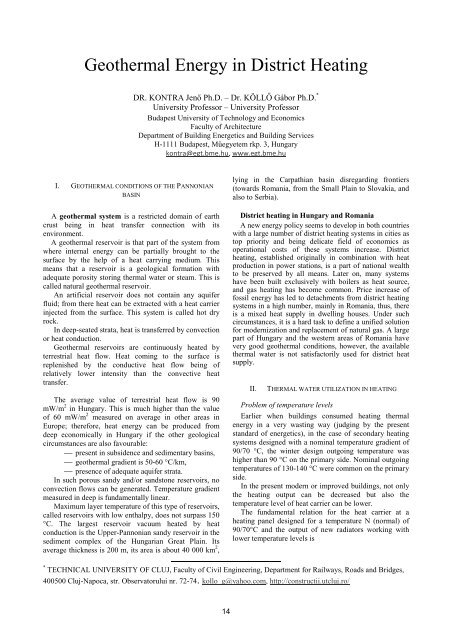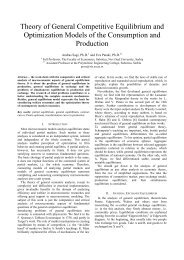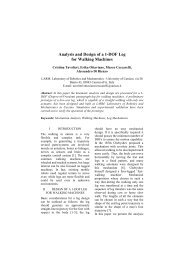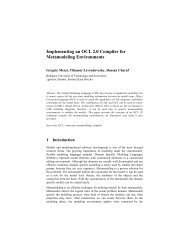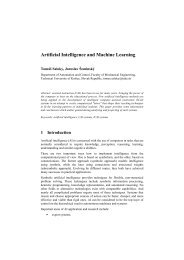Final Program EXPRES 2012 - Conferences
Final Program EXPRES 2012 - Conferences
Final Program EXPRES 2012 - Conferences
- No tags were found...
You also want an ePaper? Increase the reach of your titles
YUMPU automatically turns print PDFs into web optimized ePapers that Google loves.
Geothermal Energy in District HeatingDR. KONTRA Jenő Ph.D. – Dr. KÖLLŐ Gábor Ph.D. *University Professor – University ProfessorBudapest University of Technology and EconomicsFaculty of ArchitectureDepartment of Building Energetics and Building ServicesH-1111 Budapest, Műegyetem rkp. 3, Hungarykontra@egt.bme.hu, www.egt.bme.huI. GEOTHERMAL CONDITIONS OF THE PANNONIANBASINA geothermal system is a restricted domain of earthcrust being in heat transfer connection with itsenvironment.A geothermal reservoir is that part of the system fromwhere internal energy can be partially brought to thesurface by the help of a heat carrying medium. Thismeans that a reservoir is a geological formation withadequate porosity storing thermal water or steam. This iscalled natural geothermal reservoir.An artificial reservoir does not contain any aquiferfluid; from there heat can be extracted with a heat carrierinjected from the surface. This system is called hot dryrock.In deep-seated strata, heat is transferred by convectionor heat conduction.Geothermal reservoirs are continuously heated byterrestrial heat flow. Heat coming to the surface isreplenished by the conductive heat flow being ofrelatively lower intensity than the convective heattransfer.The average value of terrestrial heat flow is 90mW/m 2 in Hungary. This is much higher than the valueof 60 mW/m 2 measured on average in other areas inEurope; therefore, heat energy can be produced fromdeep economically in Hungary if the other geologicalcircumstances are also favourable:⎯ present in subsidence and sedimentary basins,⎯ geothermal gradient is 50-60 °C/km,⎯ presence of adequate aquifer strata.In such porous sandy and/or sandstone reservoirs, noconvection flows can be generated. Temperature gradientmeasured in deep is fundamentally linear.Maximum layer temperature of this type of reservoirs,called reservoirs with low enthalpy, does not surpass 150°C. The largest reservoir vacuum heated by heatconduction is the Upper-Pannonian sandy reservoir in thesediment complex of the Hungarian Great Plain. Itsaverage thickness is 200 m, its area is about 40 000 km 2 ,lying in the Carpathian basin disregarding frontiers(towards Romania, from the Small Plain to Slovakia, andalso to Serbia).District heating in Hungary and RomaniaA new energy policy seems to develop in both countrieswith a large number of district heating systems in cities astop priority and being delicate field of economics asoperational costs of these systems increase. Districtheating, established originally in combination with heatproduction in power stations, is a part of national wealthto be preserved by all means. Later on, many systemshave been built exclusively with boilers as heat source,and gas heating has become common. Price increase offossil energy has led to detachments from district heatingsystems in a high number, mainly in Romania, thus, thereis a mixed heat supply in dwelling houses. Under suchcircumstances, it is a hard task to define a unified solutionfor modernization and replacement of natural gas. A largepart of Hungary and the western areas of Romania havevery good geothermal conditions, however, the availablethermal water is not satisfactorily used for district heatsupply.II.THERMAL WATER UTILIZATION IN HEATINGProblem of temperature levelsEarlier when buildings consumed heating thermalenergy in a very wasting way (judging by the presentstandard of energetics), in the case of secondary heatingsystems designed with a nominal temperature gradient of90/70 °C, the winter design outgoing temperature washigher than 90 °C on the primary side. Nominal outgoingtemperatures of 130-140 °C were common on the primaryside.In the present modern or improved buildings, not onlythe heating output can be decreased but also thetemperature level of heat carrier can be lower.The fundamental relation for the heat carrier at aheating panel designed for a temperature N (normal) of90/70°C and the output of new radiators working withlower temperature levels is* TECHNICAL UNIVERSITY OF CLUJ, Faculty of Civil Engineering, Department for Railways, Roads and Bridges,400500 Cluj-Napoca, str. Observatorului nr. 72-74. kollo_g@yahoo.com, http://constructii.utcluj.ro/14


